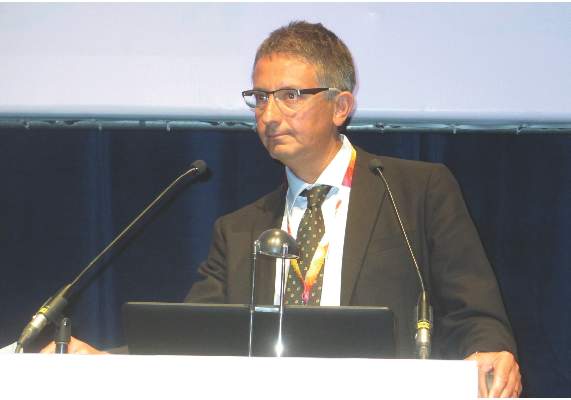User login
MADRID – Liquid biopsies to track genetic changes in a patient’s tumor by serial blood specimens rather than multiple tissue biopsies seem poised to enter routine clinical use. But several experts speaking at a session on the topic agreed that liquid biopsy technologies largely remain too unproven to enter everyday practice right now.
“I have no doubt [liquid biopsy] will become routine, but right now the evidence is lacking,” said Alberto Bardelli, Ph.D., summarizing a session he cochaired at the European Society for Medical Oncology Congress.
“I think the potential is very high to use liquid biopsy to monitor residual disease in patients with breast cancer or other tumor types. There is also the possibility of using CTCs [circulating tumor cells] to interrogate the genome of single tumor cells or to grow the cells and use them functionally” to, for example, help identify effective treatments against the tumor, said Dr. Bardelli, a molecular biologist at the University of Torino, Italy.
Liquid biopsies are generally divided into two categories. One approach involves the isolation and analysis of individual, living tumor cells that slough off a primary tumor or metastasis and can be isolated from a patient’s peripheral blood, although tumor cell concentrations are very low, on the order of one tumor cell in a million normal blood cells or even 10- to 100-fold more dilute than that.
In 2004, the Food and Drug Administration approved CellSearch, a commercial test that quantifies CTCs in patients with metastatic breast cancer to predict the likelihood of survival. CellSearch remains the only FDA-approved liquid biopsy assay for cancer, though its use has expanded to patients with prostate or colorectal cancer as well as breast cancer.
Circulating tumor DNA
The second option is to isolate and analyze the DNA that slips out of dead tumor cells and enters a patient’s circulation. One advantage of focusing on circulating tumor DNA (ctDNA) is that it is more than 100 times as common in a patent’s blood as tumor cells; however, tumor DNA is limited to providing a broad-brush average of what is going on genetically in a primary tumor and its metastases at any time, rather than giving the specificity of a genome isolated from a single, circulating tumor cell.
Both approaches seem to have value, and both seem on course to continue in development and be used in complementary ways.
An example of the potential benefit of analyzing ctDNA came in a study published last year, in which investigators identified genetic alterations that they could use to follow patients with metastatic breast cancer. They found ctDNA in the blood of 29 out of 52 women, and saw a strong, inverse relationship between increased levels of ctDNA and survival. Patients with a below-average level of ctDNA had significantly better survival, while patients with relatively higher ctDNA levels had significantly worse survival, the British researchers reported last year (New Engl. J. Med. 2013;368:1199-209). The study results also showed that quantifying ctDNA provided better correlation with changes in tumor burden than did quantifying CTCs or measuring an immune marker for breast cancer, CA 15-3.
More recently, these investigators expanded the mutation panel they use to identify ctDNA, and now can find a single-nucleotide or structural variant in the DNAs of 48 of these 52 patients, Dr. Carlos Caldas, one of the investigators, said in a talk at the meeting. Dr. Caldas added that he and his associates have now seen a patient from this series with triple-negative breast cancer and an elevated level of ctDNA who then showed a dramatic reduction in ctDNA level following several treatment cycles. This drop in ctDNA level tracked with the patient’s complete pathological response to treatment.
“This is preliminary evidence that you can use ctDNA as a very early marker of treatment response,” said Dr. Caldas, professor of cancer medicine at the University of Cambridge, England.
Other advantages of measuring ctDNA, especially compared with tracking a tumor using CTCs, is that it is simple and relatively inexpensive, with no need for special isolation technology, and it reflects the patient’s total tumor burden, noted Dr. Gerald Prager, an oncologist at the Medical University of Vienna. He cited a recent example of the power of ctDNA analysis in a report on 106 patients with colorectal cancer, who underwent ctDNA analysis for KRAS and BRAF mutations. Comparison of results from the ctDNA analysis and conventional mutation determinations showed 100% sensitivity and specificity for detecting tumors with the BRAF V600E mutation, and 98% specificity and 92% sensitivity for detecting any of seven KRAS point mutations (Nature Med. 2014;20:430-5).
“We think that liquid biopsies can help deliver the right treatment to a patient at the right time, and less invasively” than tissue biopsies, Dr. Prager said in a talk at the meeting. “They are useful for monitoring tumor growth and therapeutic activity.” He and his associates now have a study in progress evaluating the ability of serial ctDNA analysis to improve treatment with regorafenib in patients with metastatic colorectal cancer.
Analyses using ctDNA “are accurate, but we need to perform clinical trials to know what we should do with the information,” Dr. Prager said in an interview. “When we see a clone has been selected, should we change treatment before we see actual disease progression? This question has not yet been answered,” he said.
Circulating tumor cells
Liquid biopsy for CTCs has the advantage over ctDNA of having an FDA-approved test, which uses epithelial-marker antigens on the surface of CTCs to isolate the cells from a 7.5-mL specimen of blood. Study results showed a clear link between increased numbers of CTCs in patients and their rate of metastatic progression. For example, a meta-analysis published this year summarized data on CTC analysis in 1,944 patients with metastatic breast cancer evaluated in 20 separate studies done at 17 European centers. This meta-analysis showed that 47% of patients had a CTC count at baseline of 5 cells or more in a 7.5-mL specimen, and that this was significantly linked to diminished overall survival (hazard ratio, 1.92; 95% confidence interval, 1.73-2.14; P < .0001) (Lancet Oncol. 2014;15:406-14). The data also showed significantly reduced survival when CTC count increased either 3-5 weeks after treatment started or 6-8 weeks after treatment started. All these findings “confirm the independent, prognostic effect of CTC count on progression-free survival and overall survival,” the authors concluded.
This report confirmed the added value of CTC number, which was first reported using the same CellSearch technology a decade before (New Engl. J. Med. 2004;351:781-91).
The 2014 meta-analysis “provides level I evidence that CTC detection with CellSearch is an adverse prognostic factor in metastatic breast cancer,” said Dr. Michail Ignatiadis, an oncologist at the Jules Bordet Institute in Brussels.
But while CTC number “gives us very good prognostication, what we want is to know whether a treatment is working, and [whether we] can we get enough information from these cells to decide on what treatment to use. That is more challenging,” said Dr. Klaus Pantel, a professor of oncology and director of tumor biology at the University of Hamburg, Germany.
“We can now say, by monitoring CTCs in blood, whether or not treatment is going in the right direction; and it is important to have an early indicator of treatment response, but the challenge is to get a good picture” of the tumor to guide drug selection, Dr. Pantel said in an interview. He has recently used a new approach to collect CTCs developed by Gilupi that employs a receptor-coated needle placed in a patient’s blood vessel and left there for 30 minutes, during which roughly a liter of blood passes by the needle, allowing for collection of many more CTCs than is possible from a 7.5-mL specimen.
Another question about CTCs is that collection works well in metastatic-stage disease, when CTCs are relatively plentiful, but can it also play a role in assessing mortality risk in patients with early-stage cancer? Dr. Pantel and his associates recently addressed this question by using the CellSearch assay in 2,026 patients with early-stage breast cancer prior to treatment with adjuvant chemotherapy, and 1,492 patients after chemotherapy. The results showed that the presence of CTCs was linked to worse prognosis, with the worst outcomes occurring in women with 5 or more CTCs in 30 mL of blood (J. Natl. Cancer Inst. 2014;106:dju066 [doi: 10.1093/jnci/dju066]). The findings are the first “to provide strong evidence for the prognostic relevance of CTCs in early breast cancer before and after adjuvant chemotherapy in a large patient cohort,” Dr. Pantel and his coauthors concluded. “Our data offer support for the clinical potential of CTCs to assess the individual risk of patients at the time of primary diagnosis.”
Coupling liquid biopsies with better treatments
One of the challenges of using liquid biopsies to improve cancer treatment is the inherent limitation researchers often encounter of having to rely on inadequate treatment regimens with limited efficacy, Dr. Ignatiadis noted. That limitation came into play in a recent report of a study that used CTCs to stratify risk in patients with metastatic breast cancer and randomize them to either of two different treatment regimens. The results confirmed the prognostic significance of CTC number but failed to show that changing treatment based on CTC number improved outcomes, likely because the alternative regimen applied offered no real advantages over the comparator, the researchers concluded (J. Clin. Oncol. 2014 June 2 [doi: 10.1200/JCO.2014.56.2561]).
Studies now in progress have been designed to specifically test the efficacy of new treatment approaches in cancer populations selected for their CTC or ctDNA profile, such as the TREAT CTC trial, which is evaluating the efficacy of trastuzumab for treating women with detectable CTCs and HER2-negative primary breast cancer. Another example is the DETECT III trial, which is investigating the efficacy of lapatinib in patients with metastatic breast cancer who have HER2-positive CTCs.
“Until now we have mostly had proof-of-principle studies. Now we need to see how CTCs and ctDNA work in real practice” and in coordination with new approaches to treatment, Dr. Pantel said.
Dr. Bardelli is a shareholder in Horizon Discovery and has been an adviser to Biocartis, Trovagene, and HD. Dr. Caldas had no disclosures. Dr. Prager has been an adviser and consultant to Bayer, Roche, Amgen, Merck Serono, and Sanofi-Aventis. Dr. Ignatiadis has received educational grants from Janssen Diagnostics and Roche. Dr. Pantel has been an adviser to Veridex/Janssen, Alere, and Gilupi.
On Twitter @mitchelzoler
MADRID – Liquid biopsies to track genetic changes in a patient’s tumor by serial blood specimens rather than multiple tissue biopsies seem poised to enter routine clinical use. But several experts speaking at a session on the topic agreed that liquid biopsy technologies largely remain too unproven to enter everyday practice right now.
“I have no doubt [liquid biopsy] will become routine, but right now the evidence is lacking,” said Alberto Bardelli, Ph.D., summarizing a session he cochaired at the European Society for Medical Oncology Congress.
“I think the potential is very high to use liquid biopsy to monitor residual disease in patients with breast cancer or other tumor types. There is also the possibility of using CTCs [circulating tumor cells] to interrogate the genome of single tumor cells or to grow the cells and use them functionally” to, for example, help identify effective treatments against the tumor, said Dr. Bardelli, a molecular biologist at the University of Torino, Italy.
Liquid biopsies are generally divided into two categories. One approach involves the isolation and analysis of individual, living tumor cells that slough off a primary tumor or metastasis and can be isolated from a patient’s peripheral blood, although tumor cell concentrations are very low, on the order of one tumor cell in a million normal blood cells or even 10- to 100-fold more dilute than that.
In 2004, the Food and Drug Administration approved CellSearch, a commercial test that quantifies CTCs in patients with metastatic breast cancer to predict the likelihood of survival. CellSearch remains the only FDA-approved liquid biopsy assay for cancer, though its use has expanded to patients with prostate or colorectal cancer as well as breast cancer.
Circulating tumor DNA
The second option is to isolate and analyze the DNA that slips out of dead tumor cells and enters a patient’s circulation. One advantage of focusing on circulating tumor DNA (ctDNA) is that it is more than 100 times as common in a patent’s blood as tumor cells; however, tumor DNA is limited to providing a broad-brush average of what is going on genetically in a primary tumor and its metastases at any time, rather than giving the specificity of a genome isolated from a single, circulating tumor cell.
Both approaches seem to have value, and both seem on course to continue in development and be used in complementary ways.
An example of the potential benefit of analyzing ctDNA came in a study published last year, in which investigators identified genetic alterations that they could use to follow patients with metastatic breast cancer. They found ctDNA in the blood of 29 out of 52 women, and saw a strong, inverse relationship between increased levels of ctDNA and survival. Patients with a below-average level of ctDNA had significantly better survival, while patients with relatively higher ctDNA levels had significantly worse survival, the British researchers reported last year (New Engl. J. Med. 2013;368:1199-209). The study results also showed that quantifying ctDNA provided better correlation with changes in tumor burden than did quantifying CTCs or measuring an immune marker for breast cancer, CA 15-3.
More recently, these investigators expanded the mutation panel they use to identify ctDNA, and now can find a single-nucleotide or structural variant in the DNAs of 48 of these 52 patients, Dr. Carlos Caldas, one of the investigators, said in a talk at the meeting. Dr. Caldas added that he and his associates have now seen a patient from this series with triple-negative breast cancer and an elevated level of ctDNA who then showed a dramatic reduction in ctDNA level following several treatment cycles. This drop in ctDNA level tracked with the patient’s complete pathological response to treatment.
“This is preliminary evidence that you can use ctDNA as a very early marker of treatment response,” said Dr. Caldas, professor of cancer medicine at the University of Cambridge, England.
Other advantages of measuring ctDNA, especially compared with tracking a tumor using CTCs, is that it is simple and relatively inexpensive, with no need for special isolation technology, and it reflects the patient’s total tumor burden, noted Dr. Gerald Prager, an oncologist at the Medical University of Vienna. He cited a recent example of the power of ctDNA analysis in a report on 106 patients with colorectal cancer, who underwent ctDNA analysis for KRAS and BRAF mutations. Comparison of results from the ctDNA analysis and conventional mutation determinations showed 100% sensitivity and specificity for detecting tumors with the BRAF V600E mutation, and 98% specificity and 92% sensitivity for detecting any of seven KRAS point mutations (Nature Med. 2014;20:430-5).
“We think that liquid biopsies can help deliver the right treatment to a patient at the right time, and less invasively” than tissue biopsies, Dr. Prager said in a talk at the meeting. “They are useful for monitoring tumor growth and therapeutic activity.” He and his associates now have a study in progress evaluating the ability of serial ctDNA analysis to improve treatment with regorafenib in patients with metastatic colorectal cancer.
Analyses using ctDNA “are accurate, but we need to perform clinical trials to know what we should do with the information,” Dr. Prager said in an interview. “When we see a clone has been selected, should we change treatment before we see actual disease progression? This question has not yet been answered,” he said.
Circulating tumor cells
Liquid biopsy for CTCs has the advantage over ctDNA of having an FDA-approved test, which uses epithelial-marker antigens on the surface of CTCs to isolate the cells from a 7.5-mL specimen of blood. Study results showed a clear link between increased numbers of CTCs in patients and their rate of metastatic progression. For example, a meta-analysis published this year summarized data on CTC analysis in 1,944 patients with metastatic breast cancer evaluated in 20 separate studies done at 17 European centers. This meta-analysis showed that 47% of patients had a CTC count at baseline of 5 cells or more in a 7.5-mL specimen, and that this was significantly linked to diminished overall survival (hazard ratio, 1.92; 95% confidence interval, 1.73-2.14; P < .0001) (Lancet Oncol. 2014;15:406-14). The data also showed significantly reduced survival when CTC count increased either 3-5 weeks after treatment started or 6-8 weeks after treatment started. All these findings “confirm the independent, prognostic effect of CTC count on progression-free survival and overall survival,” the authors concluded.
This report confirmed the added value of CTC number, which was first reported using the same CellSearch technology a decade before (New Engl. J. Med. 2004;351:781-91).
The 2014 meta-analysis “provides level I evidence that CTC detection with CellSearch is an adverse prognostic factor in metastatic breast cancer,” said Dr. Michail Ignatiadis, an oncologist at the Jules Bordet Institute in Brussels.
But while CTC number “gives us very good prognostication, what we want is to know whether a treatment is working, and [whether we] can we get enough information from these cells to decide on what treatment to use. That is more challenging,” said Dr. Klaus Pantel, a professor of oncology and director of tumor biology at the University of Hamburg, Germany.
“We can now say, by monitoring CTCs in blood, whether or not treatment is going in the right direction; and it is important to have an early indicator of treatment response, but the challenge is to get a good picture” of the tumor to guide drug selection, Dr. Pantel said in an interview. He has recently used a new approach to collect CTCs developed by Gilupi that employs a receptor-coated needle placed in a patient’s blood vessel and left there for 30 minutes, during which roughly a liter of blood passes by the needle, allowing for collection of many more CTCs than is possible from a 7.5-mL specimen.
Another question about CTCs is that collection works well in metastatic-stage disease, when CTCs are relatively plentiful, but can it also play a role in assessing mortality risk in patients with early-stage cancer? Dr. Pantel and his associates recently addressed this question by using the CellSearch assay in 2,026 patients with early-stage breast cancer prior to treatment with adjuvant chemotherapy, and 1,492 patients after chemotherapy. The results showed that the presence of CTCs was linked to worse prognosis, with the worst outcomes occurring in women with 5 or more CTCs in 30 mL of blood (J. Natl. Cancer Inst. 2014;106:dju066 [doi: 10.1093/jnci/dju066]). The findings are the first “to provide strong evidence for the prognostic relevance of CTCs in early breast cancer before and after adjuvant chemotherapy in a large patient cohort,” Dr. Pantel and his coauthors concluded. “Our data offer support for the clinical potential of CTCs to assess the individual risk of patients at the time of primary diagnosis.”
Coupling liquid biopsies with better treatments
One of the challenges of using liquid biopsies to improve cancer treatment is the inherent limitation researchers often encounter of having to rely on inadequate treatment regimens with limited efficacy, Dr. Ignatiadis noted. That limitation came into play in a recent report of a study that used CTCs to stratify risk in patients with metastatic breast cancer and randomize them to either of two different treatment regimens. The results confirmed the prognostic significance of CTC number but failed to show that changing treatment based on CTC number improved outcomes, likely because the alternative regimen applied offered no real advantages over the comparator, the researchers concluded (J. Clin. Oncol. 2014 June 2 [doi: 10.1200/JCO.2014.56.2561]).
Studies now in progress have been designed to specifically test the efficacy of new treatment approaches in cancer populations selected for their CTC or ctDNA profile, such as the TREAT CTC trial, which is evaluating the efficacy of trastuzumab for treating women with detectable CTCs and HER2-negative primary breast cancer. Another example is the DETECT III trial, which is investigating the efficacy of lapatinib in patients with metastatic breast cancer who have HER2-positive CTCs.
“Until now we have mostly had proof-of-principle studies. Now we need to see how CTCs and ctDNA work in real practice” and in coordination with new approaches to treatment, Dr. Pantel said.
Dr. Bardelli is a shareholder in Horizon Discovery and has been an adviser to Biocartis, Trovagene, and HD. Dr. Caldas had no disclosures. Dr. Prager has been an adviser and consultant to Bayer, Roche, Amgen, Merck Serono, and Sanofi-Aventis. Dr. Ignatiadis has received educational grants from Janssen Diagnostics and Roche. Dr. Pantel has been an adviser to Veridex/Janssen, Alere, and Gilupi.
On Twitter @mitchelzoler
MADRID – Liquid biopsies to track genetic changes in a patient’s tumor by serial blood specimens rather than multiple tissue biopsies seem poised to enter routine clinical use. But several experts speaking at a session on the topic agreed that liquid biopsy technologies largely remain too unproven to enter everyday practice right now.
“I have no doubt [liquid biopsy] will become routine, but right now the evidence is lacking,” said Alberto Bardelli, Ph.D., summarizing a session he cochaired at the European Society for Medical Oncology Congress.
“I think the potential is very high to use liquid biopsy to monitor residual disease in patients with breast cancer or other tumor types. There is also the possibility of using CTCs [circulating tumor cells] to interrogate the genome of single tumor cells or to grow the cells and use them functionally” to, for example, help identify effective treatments against the tumor, said Dr. Bardelli, a molecular biologist at the University of Torino, Italy.
Liquid biopsies are generally divided into two categories. One approach involves the isolation and analysis of individual, living tumor cells that slough off a primary tumor or metastasis and can be isolated from a patient’s peripheral blood, although tumor cell concentrations are very low, on the order of one tumor cell in a million normal blood cells or even 10- to 100-fold more dilute than that.
In 2004, the Food and Drug Administration approved CellSearch, a commercial test that quantifies CTCs in patients with metastatic breast cancer to predict the likelihood of survival. CellSearch remains the only FDA-approved liquid biopsy assay for cancer, though its use has expanded to patients with prostate or colorectal cancer as well as breast cancer.
Circulating tumor DNA
The second option is to isolate and analyze the DNA that slips out of dead tumor cells and enters a patient’s circulation. One advantage of focusing on circulating tumor DNA (ctDNA) is that it is more than 100 times as common in a patent’s blood as tumor cells; however, tumor DNA is limited to providing a broad-brush average of what is going on genetically in a primary tumor and its metastases at any time, rather than giving the specificity of a genome isolated from a single, circulating tumor cell.
Both approaches seem to have value, and both seem on course to continue in development and be used in complementary ways.
An example of the potential benefit of analyzing ctDNA came in a study published last year, in which investigators identified genetic alterations that they could use to follow patients with metastatic breast cancer. They found ctDNA in the blood of 29 out of 52 women, and saw a strong, inverse relationship between increased levels of ctDNA and survival. Patients with a below-average level of ctDNA had significantly better survival, while patients with relatively higher ctDNA levels had significantly worse survival, the British researchers reported last year (New Engl. J. Med. 2013;368:1199-209). The study results also showed that quantifying ctDNA provided better correlation with changes in tumor burden than did quantifying CTCs or measuring an immune marker for breast cancer, CA 15-3.
More recently, these investigators expanded the mutation panel they use to identify ctDNA, and now can find a single-nucleotide or structural variant in the DNAs of 48 of these 52 patients, Dr. Carlos Caldas, one of the investigators, said in a talk at the meeting. Dr. Caldas added that he and his associates have now seen a patient from this series with triple-negative breast cancer and an elevated level of ctDNA who then showed a dramatic reduction in ctDNA level following several treatment cycles. This drop in ctDNA level tracked with the patient’s complete pathological response to treatment.
“This is preliminary evidence that you can use ctDNA as a very early marker of treatment response,” said Dr. Caldas, professor of cancer medicine at the University of Cambridge, England.
Other advantages of measuring ctDNA, especially compared with tracking a tumor using CTCs, is that it is simple and relatively inexpensive, with no need for special isolation technology, and it reflects the patient’s total tumor burden, noted Dr. Gerald Prager, an oncologist at the Medical University of Vienna. He cited a recent example of the power of ctDNA analysis in a report on 106 patients with colorectal cancer, who underwent ctDNA analysis for KRAS and BRAF mutations. Comparison of results from the ctDNA analysis and conventional mutation determinations showed 100% sensitivity and specificity for detecting tumors with the BRAF V600E mutation, and 98% specificity and 92% sensitivity for detecting any of seven KRAS point mutations (Nature Med. 2014;20:430-5).
“We think that liquid biopsies can help deliver the right treatment to a patient at the right time, and less invasively” than tissue biopsies, Dr. Prager said in a talk at the meeting. “They are useful for monitoring tumor growth and therapeutic activity.” He and his associates now have a study in progress evaluating the ability of serial ctDNA analysis to improve treatment with regorafenib in patients with metastatic colorectal cancer.
Analyses using ctDNA “are accurate, but we need to perform clinical trials to know what we should do with the information,” Dr. Prager said in an interview. “When we see a clone has been selected, should we change treatment before we see actual disease progression? This question has not yet been answered,” he said.
Circulating tumor cells
Liquid biopsy for CTCs has the advantage over ctDNA of having an FDA-approved test, which uses epithelial-marker antigens on the surface of CTCs to isolate the cells from a 7.5-mL specimen of blood. Study results showed a clear link between increased numbers of CTCs in patients and their rate of metastatic progression. For example, a meta-analysis published this year summarized data on CTC analysis in 1,944 patients with metastatic breast cancer evaluated in 20 separate studies done at 17 European centers. This meta-analysis showed that 47% of patients had a CTC count at baseline of 5 cells or more in a 7.5-mL specimen, and that this was significantly linked to diminished overall survival (hazard ratio, 1.92; 95% confidence interval, 1.73-2.14; P < .0001) (Lancet Oncol. 2014;15:406-14). The data also showed significantly reduced survival when CTC count increased either 3-5 weeks after treatment started or 6-8 weeks after treatment started. All these findings “confirm the independent, prognostic effect of CTC count on progression-free survival and overall survival,” the authors concluded.
This report confirmed the added value of CTC number, which was first reported using the same CellSearch technology a decade before (New Engl. J. Med. 2004;351:781-91).
The 2014 meta-analysis “provides level I evidence that CTC detection with CellSearch is an adverse prognostic factor in metastatic breast cancer,” said Dr. Michail Ignatiadis, an oncologist at the Jules Bordet Institute in Brussels.
But while CTC number “gives us very good prognostication, what we want is to know whether a treatment is working, and [whether we] can we get enough information from these cells to decide on what treatment to use. That is more challenging,” said Dr. Klaus Pantel, a professor of oncology and director of tumor biology at the University of Hamburg, Germany.
“We can now say, by monitoring CTCs in blood, whether or not treatment is going in the right direction; and it is important to have an early indicator of treatment response, but the challenge is to get a good picture” of the tumor to guide drug selection, Dr. Pantel said in an interview. He has recently used a new approach to collect CTCs developed by Gilupi that employs a receptor-coated needle placed in a patient’s blood vessel and left there for 30 minutes, during which roughly a liter of blood passes by the needle, allowing for collection of many more CTCs than is possible from a 7.5-mL specimen.
Another question about CTCs is that collection works well in metastatic-stage disease, when CTCs are relatively plentiful, but can it also play a role in assessing mortality risk in patients with early-stage cancer? Dr. Pantel and his associates recently addressed this question by using the CellSearch assay in 2,026 patients with early-stage breast cancer prior to treatment with adjuvant chemotherapy, and 1,492 patients after chemotherapy. The results showed that the presence of CTCs was linked to worse prognosis, with the worst outcomes occurring in women with 5 or more CTCs in 30 mL of blood (J. Natl. Cancer Inst. 2014;106:dju066 [doi: 10.1093/jnci/dju066]). The findings are the first “to provide strong evidence for the prognostic relevance of CTCs in early breast cancer before and after adjuvant chemotherapy in a large patient cohort,” Dr. Pantel and his coauthors concluded. “Our data offer support for the clinical potential of CTCs to assess the individual risk of patients at the time of primary diagnosis.”
Coupling liquid biopsies with better treatments
One of the challenges of using liquid biopsies to improve cancer treatment is the inherent limitation researchers often encounter of having to rely on inadequate treatment regimens with limited efficacy, Dr. Ignatiadis noted. That limitation came into play in a recent report of a study that used CTCs to stratify risk in patients with metastatic breast cancer and randomize them to either of two different treatment regimens. The results confirmed the prognostic significance of CTC number but failed to show that changing treatment based on CTC number improved outcomes, likely because the alternative regimen applied offered no real advantages over the comparator, the researchers concluded (J. Clin. Oncol. 2014 June 2 [doi: 10.1200/JCO.2014.56.2561]).
Studies now in progress have been designed to specifically test the efficacy of new treatment approaches in cancer populations selected for their CTC or ctDNA profile, such as the TREAT CTC trial, which is evaluating the efficacy of trastuzumab for treating women with detectable CTCs and HER2-negative primary breast cancer. Another example is the DETECT III trial, which is investigating the efficacy of lapatinib in patients with metastatic breast cancer who have HER2-positive CTCs.
“Until now we have mostly had proof-of-principle studies. Now we need to see how CTCs and ctDNA work in real practice” and in coordination with new approaches to treatment, Dr. Pantel said.
Dr. Bardelli is a shareholder in Horizon Discovery and has been an adviser to Biocartis, Trovagene, and HD. Dr. Caldas had no disclosures. Dr. Prager has been an adviser and consultant to Bayer, Roche, Amgen, Merck Serono, and Sanofi-Aventis. Dr. Ignatiadis has received educational grants from Janssen Diagnostics and Roche. Dr. Pantel has been an adviser to Veridex/Janssen, Alere, and Gilupi.
On Twitter @mitchelzoler
EXPERT ANALYSIS FROM ESMO 2014





